Towards the final filter
Towards the final filter [07-09-2006]
With some financial support of interested people, I've bought some good quality components (IT copper foil inductors, Audyn Cap Plus MKP capacitors), and based on the result I've tweaked the filter a bit.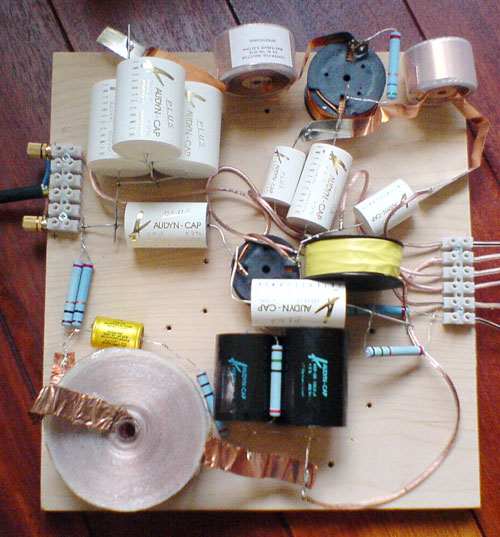
The change of the components immediately solved one of the "major problems", the lack of significant push and energy in the fundamental range (it was there, but it missed the energy as available in the other frequency ranges). Now the whole range is energetic, fast and coherent. Also pinpointing increased dramatically, the shape of the instruments have an enormous stability for the whole frequency range.
Based on the timbre, I made some minor modifications to the previous filter of 2-8-2006. There is a slight sibilance, and I've added a resistor in parallel to L8 to dampen the electrical resonance that is hidden underneath the curves. The filter is very sensitive to component variations, and this resistor dampens the resonance at this point. As a side-effect it flattens the frequency response in the treble a bit more, so R11 can be lowered. It greatly improved treble, it is more "mellow" and coherent, without loosing any resolution". Another modification is R3, in parallel of the woofer. This makes the bass more stable and punchy, not sacrificing deep bass.
The schematics and the characteristics are as follows.
The crossover circuit realizes an acoustic second order Linkwitz-Riley response between woofer and midrange, and an acoustic fourth-order Linkwitz-Riley response between midrange and tweeter. The crossover frequencies are roughly at 250Hz and 3.5kHz. You can click on the circuit to see a full scale version.

The resulting on-axis response is quite flat. There is a +1dB peak at 500Hz, a -2dB dip at 800Hz, and a +2B peak at 12 kHz, all caused by the separate response of the single units. Besides these, the response is flat within 1dB. The -3dB point in the bass region is at 45Hz. One should realize though that the curves are anechoic, and bass will be increased due to floor reflections. The amount of bass can be easily tuned with R1.
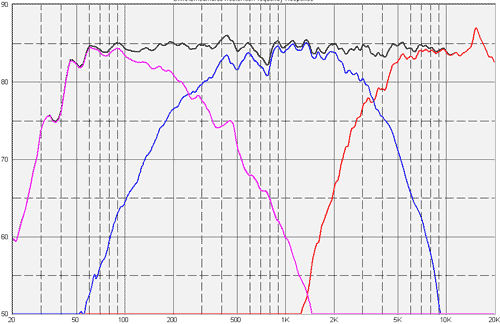
The phases of the units are aligned in their crossover range, and even far outside the crossover ranges. This makes the speaker less sensitive to the exact positioning of the listener.
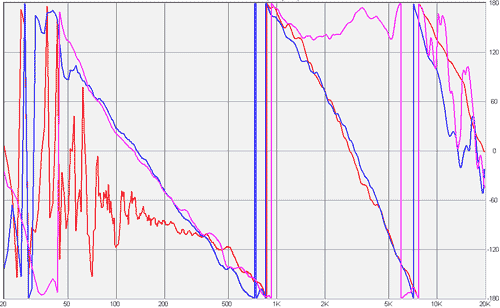
The on-axis and off-axis response are perfectly aligned as well. There are some small discrepancies around 3.5kHz and 8kHz, caused by tweeter diffractions, and above 10kHz the tweeter starts to bundle.
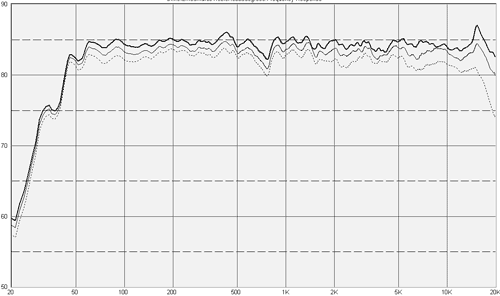
The electrical response of the filter has been made such that there are no resonances. This is the reason for the presence of some resistors (R1, R3, R10, R11), preventing boomy bass and aggressive sibilant treble.

The impedance shows a peak at 1.5kHz.

This might introduce more "presence" to the speaker when used with high-impedant sources (e.g. tube amplifiers), so an optional impedance compensation circuit can be applied:

Despite the moderate efficiency of 85dB/W, the speaker operates very well with for instance a 12W single-ended 300B amp. It can play very loud, without a hint of "scratching distortion". The bass, though less tight than with my own Ayre AX-7 amplifier, still sound solid and punchy.
I'm very satisfied with the result so far. Technically it has good properties, like a flat response, good phase alignment and good off-axis response. As far as sound is concerned, my observations, and the observations of other listeners are:
- Speed: The speaker makes a "fast" impression, meaning the attack of drums and snare instruments is instant, the decay of sound is not disturbed by resonances.
- Energy: The speaker communicates a lot of energy. Instruments with enclosures, like piano or guitar, have a "push", whereas "small" instruments or instruments recorded in large concert halls do sound more "airy".
- Resolution: It has an enormous resolution, as clean as what you find with some electrostatic loudspeakers, but with the dynamics of traditional units.
- Timbre: Homogeneous, but due to the wide off-axis and energetic response, there is quite some interaction with the listening room and position of the speakers (e.g. confirmed when holding some pillow behind the ears - no photos please - realizing a much more smooth timbre, or by repositioning the speakers with just a few cm). Though the timbre is "warm", it is not "smooth" or "romantic", but rather direct.
- Bass: Deep, solid, and well controlled. Due to physical limitations, it misses punch in the very deep regions (though energetic, a base drum doesn't kick into your stomach), but it makes an overall energetic impression in the whole range.
- Treble: Crisp, brilliant and detailed. Different cymbals all have their own specific sound characteristic, and depending on the recording technique they either sing, or sound blunt. Sibilant recordings are played without mercy, so with some recordings the speaker may sound somewhat aggressive. I cross checked many recordings for sibilance on my collection of headphones (e.g. Sennheiser HD650, Etymotics ER-4S), ad each time the record was to be blamed. Due to the wide off-axis response, sibilance gets quit some prominence.
- Mid: Voices have a natural appearance, close to what I like so much about the Audio Note E, my previous speaker. When the speaker is played loudly the mid can become prominent or "shut in/closed/guttural sounding". Measurements have shown that the interaction with my listening room is significant, and the "pillow trick" reduced mid prominence drastically. I've tried a lot of filter tweaking in this range (up to 10dB suppression), but without success, confirming the listening room dominance.
- Spatial image: In my humble opinion, incredible! Very wide and deep, and airy. Direct sound and reverbant sound is easy to distinguish. Especially with classical orchestral music, there is the sense of an orchestral hall in a living room. What is striking is that sound sources are accurately and stable positioned, despite change in frequency range or amplitude.
- Musical: A the end, this is where it is all about! When playing tracks to "check the outcome of a filter change", I find myself listening to whole tracks or to complete CDs, instead of quickly browsing. In rare cases, mid prominence or sibilant recordings can distract my attention, but as the room interacts heavily it is often a matter of lowering the volume a bit, so that the disturbing room reflection drop below some threshold.
To conclude, this filter will be very close to the final result. I hardly see room for further improvements. So what actions are left, that might affect the current filter?
1. I will replace the last few components with foil inductors and Audyn Cap Plus capacitors, which might result in a few mOhms of tweaking to rebalance the timbre. The same things hold for removing the plastic connectors, and re-apply some new wiring inside the speakers.
2. There is a audible resonance at 420 Hz (for instance obvious in the solo guitar played by Sharon Isbin, where the G# - the second "high" tone played loudly - is much louder than it should be). The C^2 79 unit spec shows this resonance clearly. This can hardly be solved by the filter, and the underlying reason needs to be found (e.g. internal cabinet reflections, units grills) and solved (e.g. change internal cabinet shape, apply bracing, apply different dampening). If acoustic means are applied, this might change the curve of the C^2 79 a bit, and this might affect the values of L6 and R6.
3. Tune the vent, to see if more punch in deep bass can be accomplished (but not at the expense of the control!). This might affect R1 and R3.
4. Maybe I come back to some timbre choices when auditioning this filter for a longer period of time (R1, R6, R8, R10, R11). I might create a somewhat more mellow treble, and fiddle with the amount of bass.
5. I will also listen to the speaker in a well-dampened room, to see whether the speaker also works well (probably even better) there.
But I guess it is obvious that large changes are not to be expected, and being realistic about the amount of spare time I have, I would be happy if I could close the project before the end of the year. So if you want to build the Milestones yourselves, I would say you're pretty safe with this filter.
Update [14-11-2006]
. Some modifications that improved the timbre a bit more.Circuit
The Milestones filter circuit and its response is given in the figures below (click on the pictures for an enlargement).
The component types are as follows. All capacitors are Audyn Cap Plus, except C2a, C2b, who are ordinary Audyn Caps. All inductors are Intertechnik Copper Foil inductors. There doesn't exist a 0.12mH version, so I bought a 0.15mH, and modified it to a 0.12mH one. Finally, all resistors are MOX-10 resistors.
I have a photo of an intermediate filter, showing some different components (e.g. a Tritec inductor):
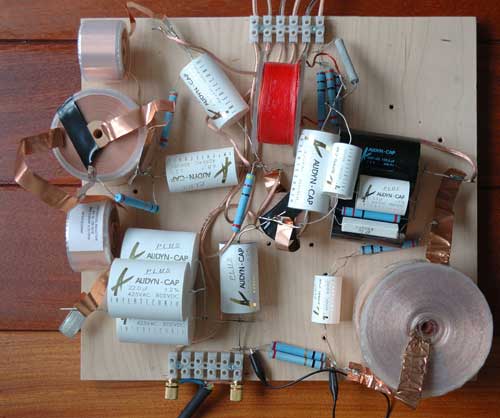
The following sections will discuss the properties of this filter.
Acoustic response
Basically the filter circuit realizes a 2nd order acoustic Linkwitz-Riley response between woofer and midrange, and a 4th-order acoustic Linkwitz-Riley response between midrange and tweeter: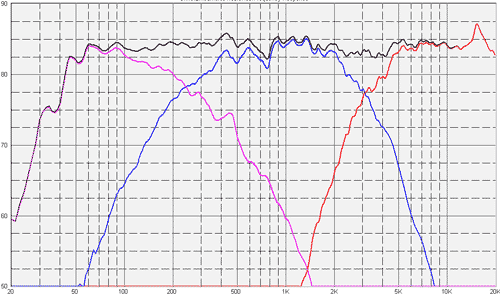
The following picture shows the fit of theoretical 2nd and 4th order Linkwitz-Riley curves:
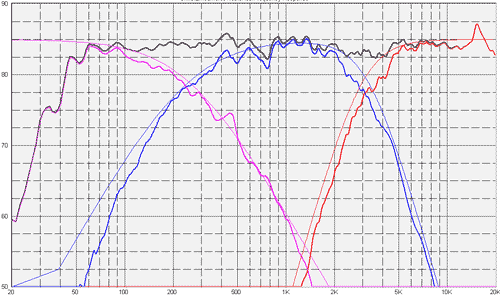
The crossover frequencies are roughly at 250Hz and 3.1kHz. A response dip in the range of 2 – 4 kHz has been created on purpose, to compensate for some harshness as experienced with a flat response curve. People, who are more confident about a flat response, can leave out R7, and lower the value of C7 to 3.3uF, though it makes the sound a bit “harder”, and affects the depth of the spatial field.
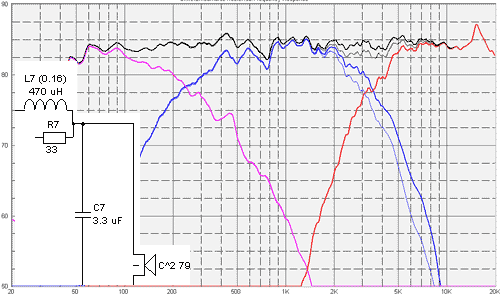
As the units have been measured in an anechoic room, they will give a bit more output in a normal listening room, and as a consequence the bass is attenuated a bit. The remaining on-axis response is quite flat. There is a +1dB peak at 500Hz, a -2dB dip at 800Hz, and a +2B peak at 12 kHz, all caused by the separate response of the single units. There are some small discrepancies around 3.5kHz and 8kHz, caused by tweeter diffractions, and above 10kHz the tweeter starts to bundle.
Linkwitz-Riley implies that the acoustic phase is aligned at crossover. I took care the phase is aligned over a very wide operating range, to make the speaker less sensitive to the exact positioning of the listener:
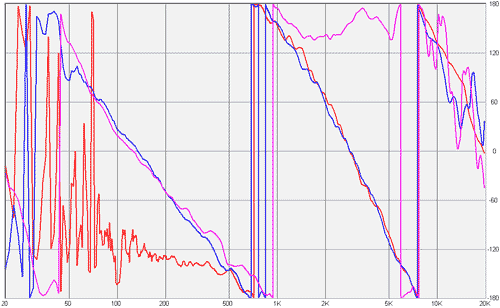
This is confirmed by looking at the midrange in reversed phase, giving steep dips at the crossover points:
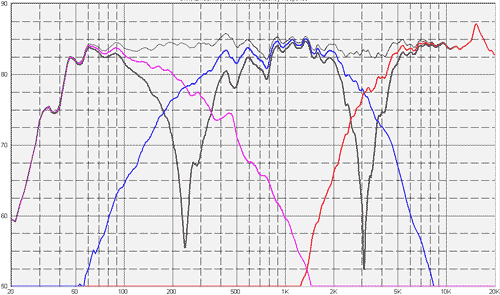
The acoustical phase alignment also results in a good overall response at different angles horizontally:

Electrical response
The electrical power response shows baffle step compensation is applied, with more power output supplied to the low frequency range: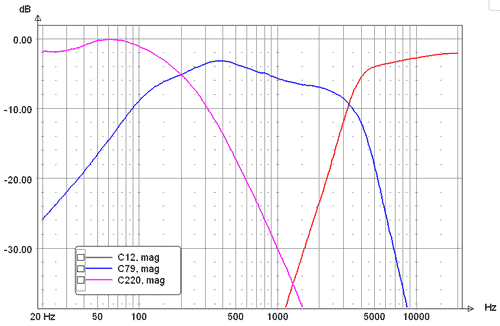
It is built up of voltage and current as follows:
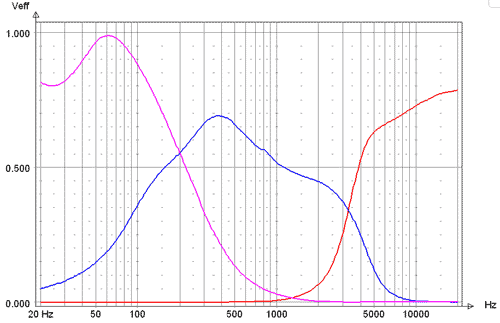
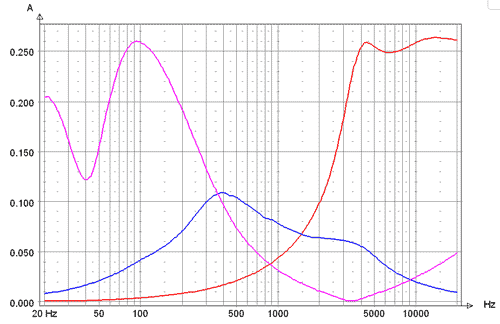
The impedance curve looks as follows:
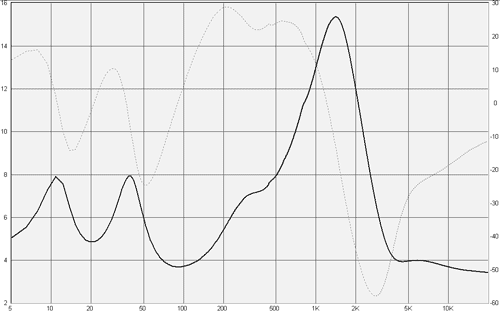
The impedance dips a little bit below 4 Ohm. The speaker has been tested with a low-power single-ended triode amplifier, and despite its moderate efficiency of 85dB/W, the speakers seems to go loud enough without the need for impedance compensation for a typical European living room situation. It can play very loud, without a hint of "scratching distortion". The bass, though less tight than with my own Ayre AX-7 amplifier, still sounds solid and punchy with a zero-feedback tube amplifier.
Filter measurements
I have measured the speaker to check the consistency of the filter and the simulation results. Because I have made these measurements in living room conditions, reverberations have affected most curves. Nevertheless, important conclusions can been drawn from these measurements.First of all, besides significant reflections from the floor and ceiling below 200 Hz, overall the response curve at 1.80 m looks very similar to the simulated response.
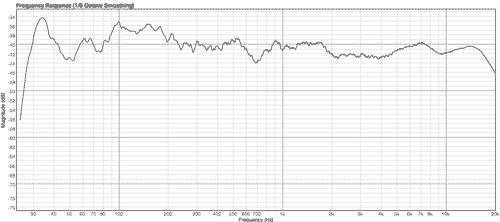
A sanity check measurement at 1-meter distance indeed shows that this peak in the response due to reflections moves up in frequency, and a dip occurs at 150Hz.
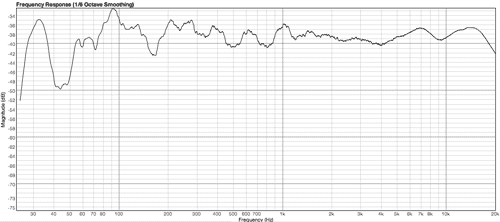
This response remains very stable over different angles (15 and 30 degrees at 1 meter), also in line with the simulations.
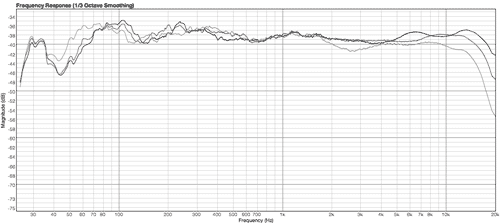
The anti-phase measurements (window width 2 ms to avoid reflections inside the measurement) show that the phase alignment is very well.
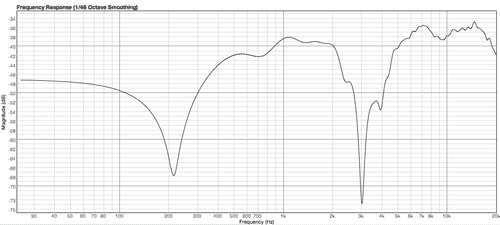
The near-field curves of the units look pretty OK, where the tweeter response falls down due to the close measurement distance, and the low-frequency measurements of the woofer are influenced a little bit by background noise. As the microphone measurement distance differs for each units due to the grills, I've adjusted the tweeter measurements with 10dB.
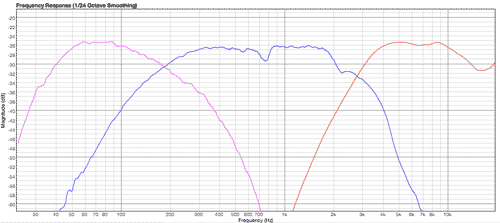
I’ve also measured the nearfield waterfall behavior of the filtered units. The “magazine measurement” of 20/30dB deep of each unit looks pretty OK (e.g. for the midrange uni (5ms, 20dB deep)t:
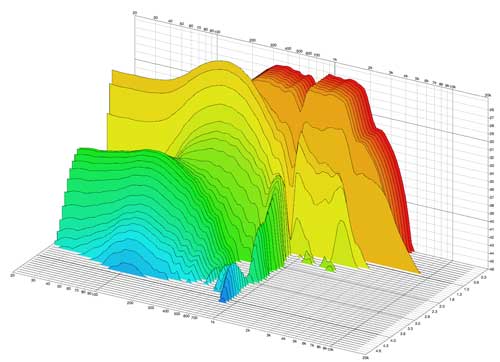
If you start to look deeper into the measurement (50dB), you can see a lot of resonances show up:
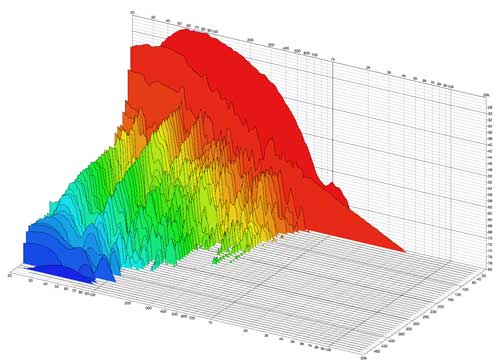
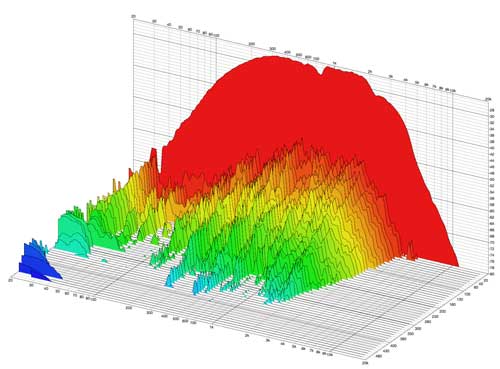
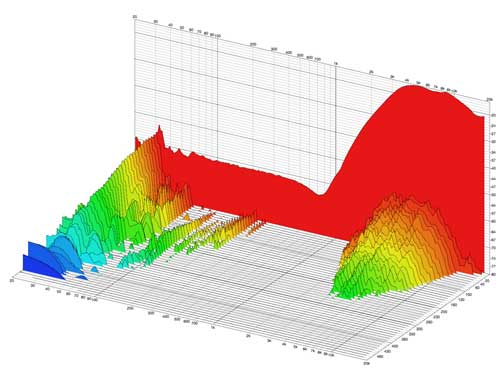
Filter implementation
I’ve spend quite some time in experimenting with components. With some financial support of interested people, I've bought some good quality components (IT copper foil inductors, Audyn Cap Plus MKP capacitors), and based on the result I've tweaked the filter a bit.My conclusion is that copper foil inductors and certain types of MKP capacitors yield good results, and contribute to a timbre that combines transparency with energy over the whole frequency range, together with good pinpointing and a wide and deep 3D image.
To do
What does it take to get to the final filter? Well, basically it is a matter of tuning R1, R3 and R11. I’m also experimenting with an RC compensation circuit in parallel with the woofer. It is a matter of trading off transparency for fullness. For this I have to judge a lot of recordings, before I’m able to finalize the filter. It will also be a matter of personal priorities, so my suggestion is that you experiment for your own situation and preference as well. I expect to finish the filter before the end of the year. It is my goal build this filter inside the cabinets. With all these big capacitors and copper foil inductors that will be quite some challenge!next->